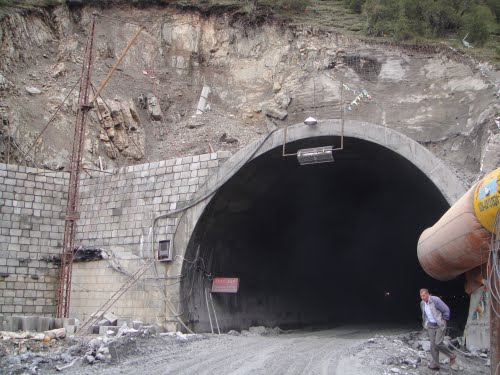
Road Projects in Tajikistan Impact Its Strategic Geography
Publication: Eurasia Daily Monitor Volume: 9 Issue: 202
By:

On October 27, Tajikistan’s President Emomalii Rahmon formally inaugurated the Shahriston tunnel along the Dushanbe-Khujand highway (BBC Tajik, October 27). The 5,253-meter tunnel cuts the time required to drive between the capital of Dushanbe and Tajikistan’s second-largest city, Khujand (Leninabad), from eight to less than four hours. The Chinese built project began six years ago and is estimated to have cost $80 million (Nahzat, July 13). Reports of passengers who have recently made the trip indicate that in addition to making the trip shorter and safer it has also cut the price by 20 percent (Ozodi, October 30). In spite of the convenience, people who regularly use the road complain about the toll system along the route, which was implemented in 2010. The system is owned and operated by an international firm called “Innovative Road Solutions,” but many complain of corruption and lack of transparency in its operation as well of the lack of alternative roads on the tolled route (https://www.faraj.tj/index.php?newsid=752; for more background see EDM, July 26; China Brief, May 25). The criticism has not been limited to pundits and disgruntled customers. Amonullah Ashur, head of Tajikistan’s Anti-Monopoly Agency, has gone so far as to accuse the firm of operating illegally (Ozodi, May 7, 2010). Despite efforts to improve the firm’s transparency and accountability over the past two years, the existence and operating practices of the toll system continues to breed resentment on the ground by both those who patronize it and those who live along its route (Ozodi, October 30).
This summer, Tajikistan also inked a deal with China Eximbank for a $50.5 million loan for construction of a road from Dushanbe to the southern city of Danghara (BBC Tajik, October 10). The firm “China Road” has been tapped to build the route, which is part of a more ambitious project to improve the Dushanbe-Kulma Pass road that connects China and Tajikistan via Badakhshan (see China Brief, May 25). Additionally, work has begun on building and improving 174 kilometers of roads connecting Aini and Panjakent that will further integrate the two primary cities of the Zarafshan Valley. The reconstruction is estimated to cost $140 million, and Asian Development bank has provided $100 million for the project (Nahzat, September 14). Given its mountainous geography, parts of the Zarafshan Valley are often difficult if not impossible to access in the winter months, making cities like Panjakent reliant on trade with the primarily ethnically Tajik city of Samarkand in Uzbekistan. While the two cities are only 60 km apart, the border crossing is subject to frequent closures resulting from political tensions between Tashkent and Dushanbe. On the one hand, the improved road could foster greater economic interdependency between Tajikistan and Uzbekistan, which could in turn improve bilateral relations. However, improved infrastructure in the Zarafshan Valley and connectivity to the rest of the country also effectively neutralizes some of Tashkent’s leverage over Dushanbe, which could embolden Tajikistan to adopt more provocative stances on hot-button issues such as water rights and border delineation.
The improvement of Tajikistan’s transportation infrastructure is important not only for trade and the Northern Distribution Network, but also has implications for Tajikistan’s strategic geography and internal cohesion. Despite being a physically small country with a legacy of Soviet rule, Tajikistan’s mountainous terrain has limited the scope of centralized authority. During his speech at the opening of the Shahriston tunnel, Rahmon referenced this fact: “Today we have built one united country out of three divided pieces.” (Ozodi, October 27). The “three pieces” that the President was referring to are central/southern Tajikistan, which includes the major cities of Dushanbe, Qurgonteppa, and Kulob; the economically vital northern region broadly demarcated by the Ferghana Valley including the cities of Khujand, Isfara and Istaravshan; and the mountainous, semi-autonomous region of Badakhshan and its provincial capital of Khorog. The new tunnel promises to better unite the first two regions, but it does little to physically integrate Khorog, which is connected to Dushanbe by a largely unpaved road that can take up to three days to traverse.
In post–civil war outbreaks of violence in Tajikistan that have necessitated the internal deployment of troops—such as those that occurred in Rasht in 2010 and Khorog this summer—military helicopters have not been sufficient to transport soldiers, and the army has had to rely heavily on roads that are not always passable in winter. It is estimated that the military has only 12 Russian MI-8 transport helicopters at its disposal. Moreover, a high profile crash in 2010 in the Rasht Valley that killed 25 members of the elite “Alpha Group” has raised doubts as to the ability of Tajikistan’s military to project air power (BBC, October 6, 2010, https://www.globalsecurity.org/military/world/centralasia/tajik-af-equipment.htm). By comparison during the three-year Second Chechen War a better trained and equipped Russian force lost 45 helicopters (23 of them MI-8s) in a mountainous counter-insurgency campaign (https://military.wikia.com/wiki/List_of_Russian_aircraft_losses_in_the_Second_Chechen_War). The new roads from the capital to Khujand and Danghara also shrink the distance between the two regions that have historically been rivals. Rahmon’s power base is centered in the city of Danghara in the region of Kulob and, while formally aligned in the civil war, the Kulobis have historically been rivals of the Khujandi nomenklatura whose clout sharply diminished after the fall of the Soviet Union. Better internal connectivity among the various regions facilitates Rahmon’s agenda of state consolidation, allowing him to rely less on local power brokers as his ability to project force from the center increases.




